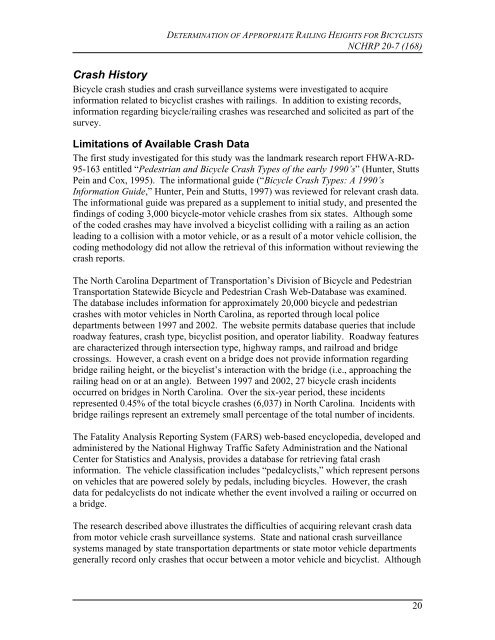Bicycle Railing Height Report - AASHTO - Subcommittee on Design
Bicycle Railing Height Report - AASHTO - Subcommittee on Design
Bicycle Railing Height Report - AASHTO - Subcommittee on Design
You also want an ePaper? Increase the reach of your titles
YUMPU automatically turns print PDFs into web optimized ePapers that Google loves.
DETERMINATION OF APPROPRIATE RAILING HEIGHTS FOR BICYCLISTS<br />
NCHRP 20-7 (168)<br />
Crash History<br />
<str<strong>on</strong>g>Bicycle</str<strong>on</strong>g> crash studies and crash surveillance systems were investigated to acquire<br />
informati<strong>on</strong> related to bicyclist crashes with railings. In additi<strong>on</strong> to existing records,<br />
informati<strong>on</strong> regarding bicycle/railing crashes was researched and solicited as part of the<br />
survey.<br />
Limitati<strong>on</strong>s of Available Crash Data<br />
The first study investigated for this study was the landmark research report FHWA-RD-<br />
95-163 entitled “Pedestrian and <str<strong>on</strong>g>Bicycle</str<strong>on</strong>g> Crash Types of the early 1990’s” (Hunter, Stutts<br />
Pein and Cox, 1995). The informati<strong>on</strong>al guide (“<str<strong>on</strong>g>Bicycle</str<strong>on</strong>g> Crash Types: A 1990’s<br />
Informati<strong>on</strong> Guide,” Hunter, Pein and Stutts, 1997) was reviewed for relevant crash data.<br />
The informati<strong>on</strong>al guide was prepared as a supplement to initial study, and presented the<br />
findings of coding 3,000 bicycle-motor vehicle crashes from six states. Although some<br />
of the coded crashes may have involved a bicyclist colliding with a railing as an acti<strong>on</strong><br />
leading to a collisi<strong>on</strong> with a motor vehicle, or as a result of a motor vehicle collisi<strong>on</strong>, the<br />
coding methodology did not allow the retrieval of this informati<strong>on</strong> without reviewing the<br />
crash reports.<br />
The North Carolina Department of Transportati<strong>on</strong>’s Divisi<strong>on</strong> of <str<strong>on</strong>g>Bicycle</str<strong>on</strong>g> and Pedestrian<br />
Transportati<strong>on</strong> Statewide <str<strong>on</strong>g>Bicycle</str<strong>on</strong>g> and Pedestrian Crash Web-Database was examined.<br />
The database includes informati<strong>on</strong> for approximately 20,000 bicycle and pedestrian<br />
crashes with motor vehicles in North Carolina, as reported through local police<br />
departments between 1997 and 2002. The website permits database queries that include<br />
roadway features, crash type, bicyclist positi<strong>on</strong>, and operator liability. Roadway features<br />
are characterized through intersecti<strong>on</strong> type, highway ramps, and railroad and bridge<br />
crossings. However, a crash event <strong>on</strong> a bridge does not provide informati<strong>on</strong> regarding<br />
bridge railing height, or the bicyclist’s interacti<strong>on</strong> with the bridge (i.e., approaching the<br />
railing head <strong>on</strong> or at an angle). Between 1997 and 2002, 27 bicycle crash incidents<br />
occurred <strong>on</strong> bridges in North Carolina. Over the six-year period, these incidents<br />
represented 0.45% of the total bicycle crashes (6,037) in North Carolina. Incidents with<br />
bridge railings represent an extremely small percentage of the total number of incidents.<br />
The Fatality Analysis <str<strong>on</strong>g>Report</str<strong>on</strong>g>ing System (FARS) web-based encyclopedia, developed and<br />
administered by the Nati<strong>on</strong>al Highway Traffic Safety Administrati<strong>on</strong> and the Nati<strong>on</strong>al<br />
Center for Statistics and Analysis, provides a database for retrieving fatal crash<br />
informati<strong>on</strong>. The vehicle classificati<strong>on</strong> includes “pedalcyclists,” which represent pers<strong>on</strong>s<br />
<strong>on</strong> vehicles that are powered solely by pedals, including bicycles. However, the crash<br />
data for pedalcyclists do not indicate whether the event involved a railing or occurred <strong>on</strong><br />
a bridge.<br />
The research described above illustrates the difficulties of acquiring relevant crash data<br />
from motor vehicle crash surveillance systems. State and nati<strong>on</strong>al crash surveillance<br />
systems managed by state transportati<strong>on</strong> departments or state motor vehicle departments<br />
generally record <strong>on</strong>ly crashes that occur between a motor vehicle and bicyclist. Although<br />
20


